The following analysis is the third in a series of reports from The Mars Agency’s Target Customer Development team that will examine the role consumer brands can play in helping the retailer’s mission critical ‘Target Forward’ initiative. This report looks at how Target is elevating owned, national and emerging brands that are not only sustainable but also affordable, inclusive and inspirational.
Read the first two reports here:
Target Forward: An ‘Always On’ Strategy for DEI
Target Forward: Every Day is Earth Day
By 2030, Target aims to be the market leader for creating and curating inclusive, sustainable brands and experiences, delivering on the Target Forward promise to co-create an equitable and regenerative future with their guests, partners and communities. One of the three pillars in that promise is to design and elevate sustainable brands, both their own and those of their supplier partners.
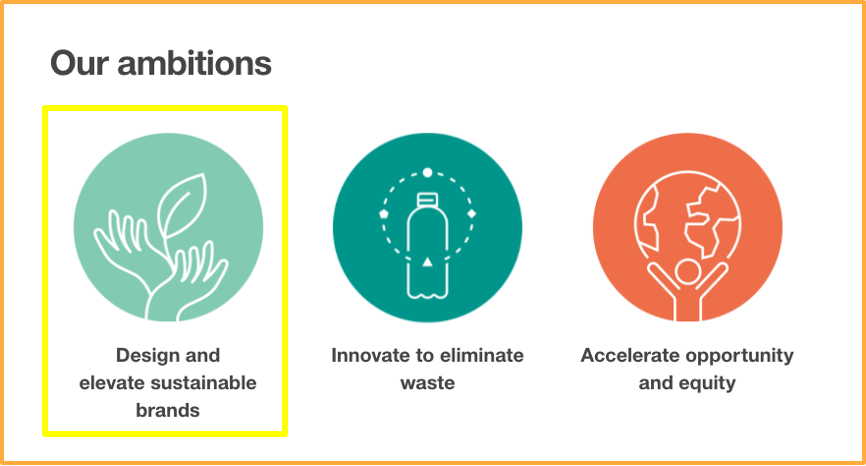
The retailer has already made significant progress with a pair of programs — Target Zero and Target Clean — that help its guests make smarter choices about the products they buy — and product manufacturers take a closer look at their practices.
Target Zero: What is it?
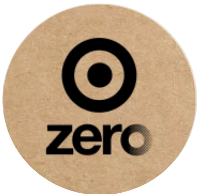
- Target’s first guest-facing sustainability initiative, the program uses a branded icon in stores and online to identify products that are designed to reduce waste.
- Launched in March 2022, the program already features hundreds of products across Target’s full category assortment.
- Under the Target Zero umbrella, Target.com guests are able to shop by category or by sustainability claim (Reusable, Refillable, Compostable Element, etc.), making it easy to find products and/or packaging designed to reduce waste.
- In stores, dedicated endcaps with signage inviting guests to join the “journey to zero waste” showcase multiple products.
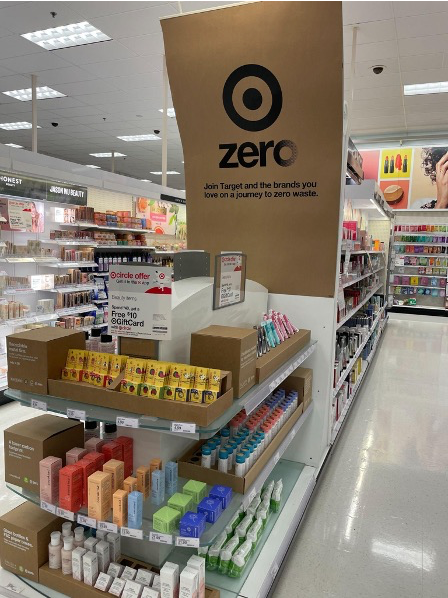
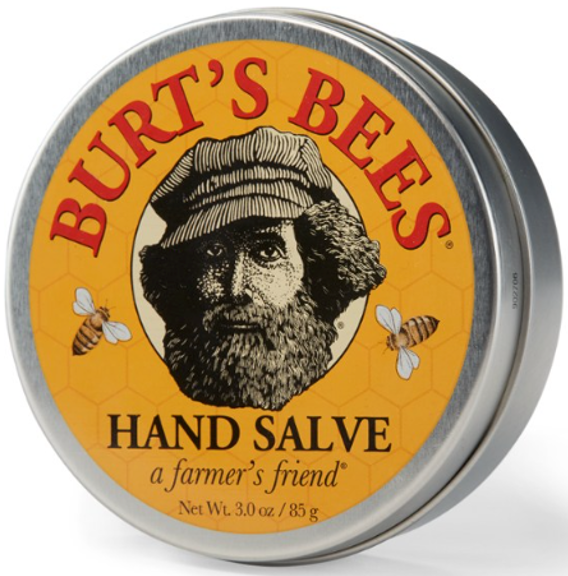
The original cohort of Target Zero brands included Burt’s Bees, PLUS, Pacifica, Grove Collaborative, and the retailer’s own Everspring. Burt’s Bees uses metal tins for some lip balms, since they’re recyclable and made without any single-use plastics. PLUS has a body wash designated Target Zero due to packaging — a dehydrated, dissolvable square — that reduces water waste.
Earning the Icon: How to Gain Target Zero Classification
Target’s aim is to offer zero-waste packaging options in every major product category by 2025. While participation is voluntary for national brands at the moment, a number of CPGs are joining the effort. To qualify, products must satisfy one or more of these criteria:
- Designed with the intention to refill, to reduce total waste.
- Designed with the intention of reusability at the end of life.
- Switched from single-use plastic to aluminum steel, glass (preferably recycled), or Forest Stewardship Council-certified paper for the majority of the packaging.
- At least 30% post-consumer recycled content for plastic (but not paper).
- Compostable packaging.
- Reduced waste usages (such as concentrates or powders).
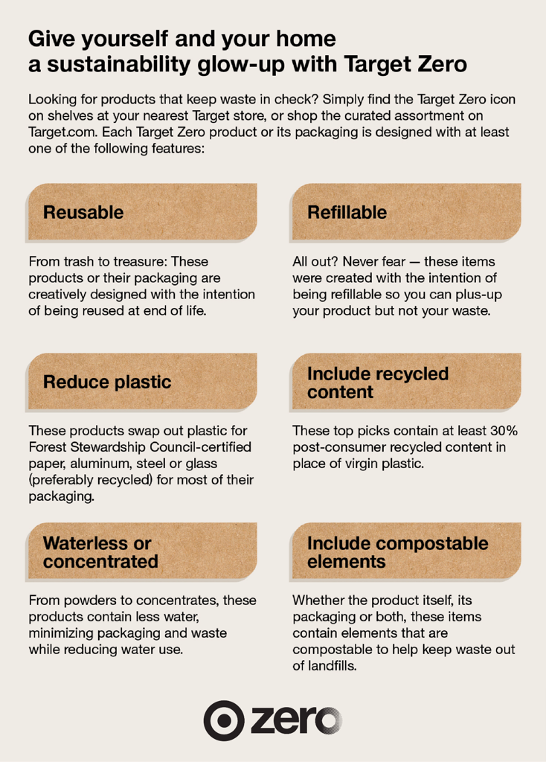
On the other hand, here is what does NOT qualify:
- General recyclability claims, including the programs conducted by Terracycle.
- In-store recycling programs/take-backs.
- Secondary packaging, like FSC-certified paper cartons that contain single-use plastic primary packaging.
Brands are directed to begin the process of qualifying for Target Zero classification by speaking with their buyer, and then providing all the necessary information about the product so that the retailer can make the proper determination. Ultimately, they will need to sign an affidavit attesting to the accuracy of all the information before the Target Zero designation is granted.
Target Clean: What is it?
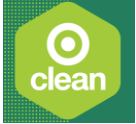
- Similarly, Target Clean makes it easy for guests to identify products that are cruelty-free in their testing and manufacturing methods and formulated without harmful chemicals.
- The three-year-old program requires greater transparency about a product’s chemical ingredients than what is currently required by law.
- In-scope categories include Beauty, Personal Care, Cleaning, Baby, Feminine Care, Pets and Insecticides, each of which have their own guidelines.
- Just like Target Zero, approved items are identified by a Target Clean icon both online and in-store.
- Target.com currently showcases 17 partners that can be shopped by brand, including Burt’s Bees, bliss, Method, Seventh Generation and the retailer’s own up & up.
On the Target Clean webpage, each category’s screened ingredient is listed, making it easy for guests to understand exactly what the products are “formulated without.”
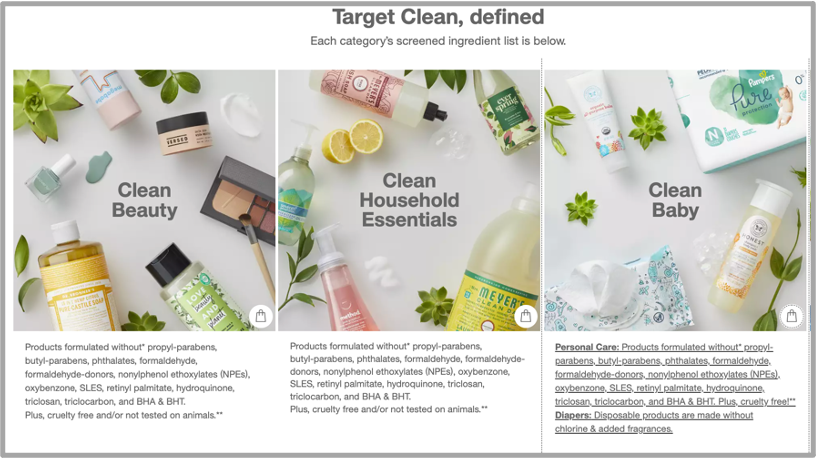
Earning the Icon: How to Gain Target Clean Classification
Target Clean classification is evaluated at the item level. The retailer takes this program very seriously and is demanding greater transparency into a product’s chemical components than what currently is required by law.
The retailer is working from one primary list of chemicals, with an additional sub-category list for deodorant & oral care products. To qualify, an item must be:
- Formulated without any of the prohibited chemical ingredients on the Target Priority Chemicals List.
- Cruelty free in the treatment of animals anywhere in the production process.
- Transparent in the disclosure of all ingredients, including subcomponents of generics such as fragrances. The manufacturer must also consent to the use of shipping, handling, storage and disposal information required by Worldwide Environmental Regulatory Compliance Solutions (WERCS).
Strategies and expectations for Target Clean products are established and managed by individual buyers, who can provide insights into whether or not an item will qualify in the short term, as well as what future modifications might be in the works.
Once the process is completed, eligible products will automatically receive the Target Clean badge on Target.com.
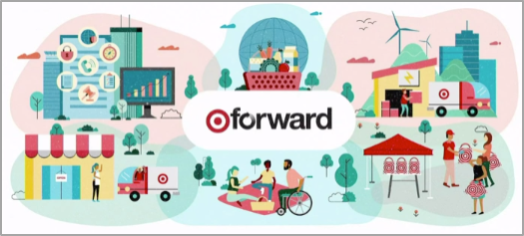
Moving Forward
With these two programs, Target is making it easier for guests to find the products online and in-store that are better alternatives both for themselves and the planet — while simultaneously using its status as a leading retailer to reduce waste and protect the environment and its inhabitants.
While many companies are putting sustainability at the forefront of their corporate initiatives, Target has taken steps to become an innovative, guiding force by encouraging supplier partners to align with Target Forward initiatives like Zero and Clean and simplifying the steps and application processes required to achieve the designations.
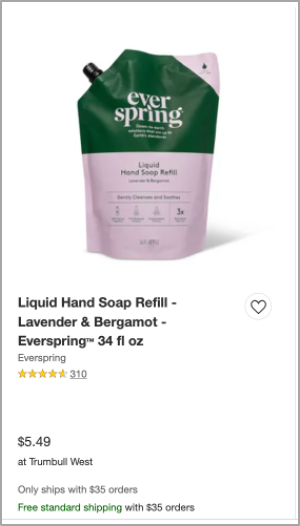
With consumer trends toward environmental awareness and healthier eating informing their strategies, Target is setting industry standards for the actions retailers can take to help their communities and our future by giving shoppers attainable and affordable purchase decisions that make a difference.
“This is just the beginning,” Erica Shea, Target senior buyer and sustainability lead for beauty, said in a recent post on the corporate blog, A Bullseye View. “We all have a role to play when it comes to making more sustainable choices, and at Target, we’re committed to not only making improvements within our business, but [to] pushing the industry as a whole to do better by our planet.”
Why Is This Important?
Consumers are placing more importance on — and paying more attention to — “clean” ingredients, natural product options, and chemical-free foods and beverages. They are increasingly eco-friendly and know that minimizing our carbon footprint is extremely important to the future.
Increasingly, consumers want to make an impact through the product choices they make, but many aren’t confident they have the right information to determine which ones are legitimately better for them and the environment. Target’s Zero and Clean certifications, and the requirements brands must meet to participate, provide a level of trust and assurance in the brands and products consumers are buying.
“Dial, a trusted brand of almost 75 years, continues to evolve and look for ways to better the lives of our consumers, and sustainability is a core brand value,” explains Jamie Rose, Senior Brand Manager of Dial Activation at Henkel. “This year, the brand further delivered on our commitment to sustainability through the launch of our innovation, Concentrated Refills, and partnerships with sustainability leaders Plastic Bank Recycling Corp., TerraCycle Inc. and Solidaridad —three like-minded organizations whose brand mission is to create a more sustainable future.”

“At Dial and across Henkel, promoting sustainability and reducing plastic waste is not only our goal but our corporate commitment,” says Rose. “Together, we will help achieve our mission by making sustainable, innovative personal care products while addressing both environmental and social challenges.”
What Can Brands Do
Although Target isn’t requiring participation in these programs, it is worthwhile for all CPGs to follow the retailer’s lead and start looking into how they can make their products and processes more sustainable and healthier:
- Evaluate your innovation pipelines in the sustainability space to see how you can aid in the Target Forward journey.
- Lean in and leverage your Roundel media programs to help deliver the Target Forward message within your activations.
- Share with your buyers the internal changes the organization is making to become leaders in Target’s plans for a sustainable, waste-free “circular future.”
Target has already pledged to make all of its owned brand products 100% “circular” by 2040. National brands that want to be good partners should be making efforts to keep pace.
____________
At The Mars Agency, we are committed to being leaders in innovation. To help our clients stay ahead of the competition in a fast-paced and constantly evolving marketplace, we closely monitor any and all news across the Target ecosystem so clients stay “in-the-know” about this key customer. Meghan Heltne, SVP-Client Leadership, heads up our Target team in Minneapolis. Contact her: [email protected]